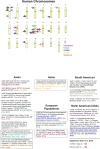Heredity, Genetics and Orthodontics - How Much Has This Research Really Helped?
- PMID: 29290679
- PMCID: PMC5743234
- DOI: 10.1053/j.sodo.2017.07.003
Heredity, Genetics and Orthodontics - How Much Has This Research Really Helped?
Abstract
Uncovering the genetic factors that correlate with a clinical deviation of previously unknown etiology helps to diminish the unknown variation influencing the phenotype. Clinical studies, particularly those that consider the effects of an appliance or treatment regimen on growth, need to be a part of these types of genetic investigations in the future. While the day-to-day utilization of "testing" for genetic factors is not ready for practice yet, genetic testing for monogenic traits such as Primary Failure of Eruption (PFE) and Class III malocclusion is showing more promise as knowledge and technology advances. Although the heterogeneous complexity of such things as facial and dental development, the physiology of tooth movement, and the occurrence of External Apical Root Resorption (EARR) make their precise prediction untenable, investigations into the genetic factors that influence different phenotypes, and how these factors may relate to or impact environmental factors (including orthodontic treatment) are becoming better understood. The most important "genetic test" the practitioner can do today is to gather the patient's individual and family history. This would greatly benefit the patient, and augment the usefulness of these families in future clinical research in which clinical findings, environmental, and genetic factors can be studied.
Figures


Similar articles
-
External apical root resorption concurrent with orthodontic forces: the genetic influence.Acta Odontol Scand. 2017 May;75(4):280-287. doi: 10.1080/00016357.2017.1294260. Epub 2017 Feb 24. Acta Odontol Scand. 2017. PMID: 28358285 Review.
-
External root resorption during orthodontic treatment in root-filled teeth and contralateral teeth with vital pulp: A clinical study of contributing factors.Am J Orthod Dentofacial Orthop. 2016 Jan;149(1):84-91. doi: 10.1016/j.ajodo.2015.06.027. Am J Orthod Dentofacial Orthop. 2016. PMID: 26718382
-
Genetic and treatment-related risk factors associated with external apical root resorption (EARR) concurrent with orthodontia.Orthod Craniofac Res. 2015 Apr;18 Suppl 1(Suppl 1):71-82. doi: 10.1111/ocr.12078. Orthod Craniofac Res. 2015. PMID: 25865535 Free PMC article.
-
Bone Density and Dental External Apical Root Resorption.Curr Osteoporos Rep. 2016 Dec;14(6):292-309. doi: 10.1007/s11914-016-0340-1. Curr Osteoporos Rep. 2016. PMID: 27766484 Free PMC article. Review.
-
Herbst appliance with skeletal anchorage versus dental anchorage in adolescents with Class II malocclusion: study protocol for a randomised controlled trial.Trials. 2017 Nov 25;18(1):564. doi: 10.1186/s13063-017-2297-5. Trials. 2017. PMID: 29178932 Free PMC article. Clinical Trial.
Cited by
-
Genetics of Dentofacial and Orthodontic Abnormalities.Glob Med Genet. 2020 Dec;7(4):95-100. doi: 10.1055/s-0040-1722303. Epub 2021 Feb 1. Glob Med Genet. 2020. PMID: 33693441 Free PMC article. Review.
-
Recent Advances in Drug Delivery and Oral Health: The Impact of Technology and Digital Advances as a New Frontier.Bioengineering (Basel). 2025 Jun 17;12(6):664. doi: 10.3390/bioengineering12060664. Bioengineering (Basel). 2025. PMID: 40564480 Free PMC article.
-
Primary failure of eruption: occlusal and dentoalveolar characteristics in mixed and permanent dentition. A study with cone beam computed tomography.J Clin Exp Dent. 2022 Jul 1;14(7):e520-e527. doi: 10.4317/jced.59657. eCollection 2022 Jul. J Clin Exp Dent. 2022. PMID: 35912030 Free PMC article.
-
Primary Failure Eruption: Genetic Investigation, Diagnosis and Treatment: A Systematic Review.Children (Basel). 2023 Nov 2;10(11):1781. doi: 10.3390/children10111781. Children (Basel). 2023. PMID: 38002872 Free PMC article. Review.
-
Genetic Testing as a Source of Information Driving Diagnosis and Therapeutic Plan in a Multidisciplinary Case.Bioengineering (Basel). 2024 Oct 14;11(10):1023. doi: 10.3390/bioengineering11101023. Bioengineering (Basel). 2024. PMID: 39451399 Free PMC article.
References
-
- Manfredi C, Martina R, Grossi GB, Giuliani M. Heritability of 39 orthodontic cephalometric parameters on MZ, DZ twins and MN-paired singletons. Am J Orthod Dentofacial Orthop. 1997;111:44–51. - PubMed
-
- Hartsfield JK, Jr, Morford LA. Genetic Implications in Orthodontic Tooth Movement. In: Shroff B, editor. Biology of Orthodontic Tooth Movement - Current Concepts and Applications in Orthodontic Practice. Springer; 2016. pp. 103–132.
-
- Mencken HL. A Mencken chrestomathy. New York: A. A. Knopf; 1949.
-
- Verdonck A, Gaethofs M, Carels C, de Zegher F. Effect of low-dose testosterone treatment on craniofacial growth in boys with delayed puberty. Eur J Orthod. 1999;21:137–143. - PubMed
-
- Moss ML. The regulation of skeletal growth Regulation of Organ and Tissue Growth. Acad Press NY: 1972. pp. 127–142.
Grants and funding
LinkOut - more resources
Full Text Sources
Other Literature Sources
